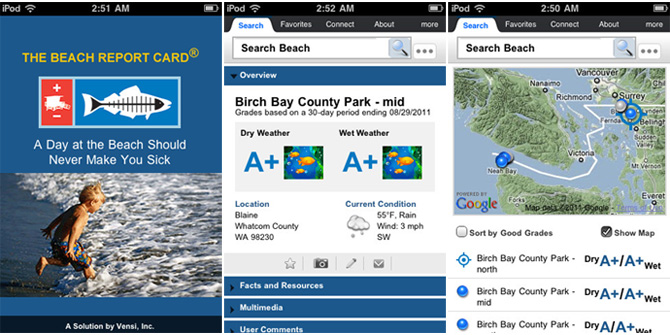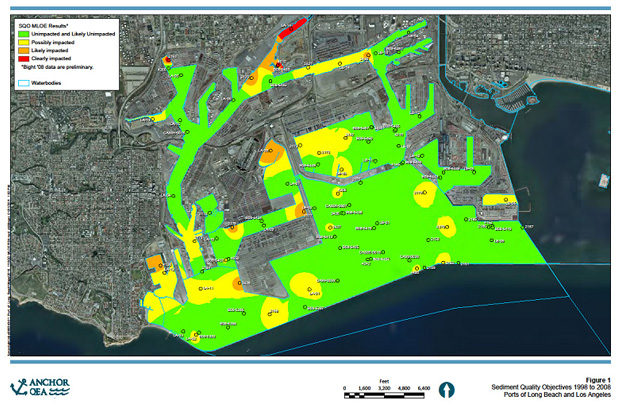We collected a sample of water off the Santa Monica Pier today, and got a bit of a surprise. Instead of the blue-gray water that we usually collect, a rusty, brownish-red liquid filled the collection jar. Welcome back red tide!
Aquarium staff has been bombarded with questions regarding what people perceive as “polluted water” these past few days. So here’s a little background on this interesting phenomenon.
The term red tide is a bit of a misnomer as the color of the water is usually not red, and the blooms are not associated with the tides. Hmm….ponder that wonder of science.
Red tides occur when there is a high concentration of mostly dinoflagellates, a small, single-celled phytoplankton that possess two flagella, or whiplike projections. The water appears as a rusty-brownish color as the light reflects off the accessory pigments in the cells of the numerous phytoplankton, or algae, floating on the surface.
Dinoflagellates reproduce by fission, meaning the single cell divides in half and then creates two new cells, and so on and so on as the population continues to grow exponentially. Under the right conditions the organisms can reproduce once a day, creating a massive population bloom. During the peak of the red tide there can often be tens or hundreds of thousands of dinoflagellates in one drop of water.
This phenomenon can occur all over the world, and about 200 species are known to cause the red tide. However, during a red tide other organisms aside from the dinoflagellates have been found, such as cyanobacteria and diatoms.
Contrary to what many believe, not all red tides are harmful. But to be clear, many can cause adverse health effects.
Many of the dinoflagellates that are responsible for these occurrences are simple organisms. However about a third of the species causing red tides have the ability to produce toxins as metabolic by-products.
During a toxic bloom, mussels, clams and other shellfish that filter feed plankton as a food source, end up concentrating high amounts of the dinoflagellates and can tolerate the toxins by storing it in digestive glands or other tissues. However, when people eat these animals they can suffer nausea/vomiting, diarrhea, tingling or numbness. Fatalities can occur in the most severe cases. This is known as Paralytic Shellfish Poisoning (PSP) and one species of dinoflagellate in the genus Alexandrium is the culprit. That’s the reason behind the annual mussel harvesting quarantine along the entire California coast from May 1- Oct. 31.
Red tides are unpredictable and the causes of them are not entirely known, however, red tides have been occurring more frequently. Some factors that may contribute to the blooms are reduced salinity, optimal light and nutrients, warm surface temperatures, transport in ballast water of ships and pollution. Sewage and fertilizer found in urban runoff contribute a high level of phosphates and nitrates into the ocean environment. Burning of fossil fuels also contributes to the amount of nitrogen, and is considered the greatest source to the open ocean environment. Excessive amounts of these nutrients cause the primary producers to grow rapidly.
Primarily a problem in coastal habitats, the algae grow quickly and reduce the amount of sunlight that is able to penetrate to the bottom. As the phytoplankton blooms and then dies, and as metabolic wastes builds up from the zooplankton and fish that feed on the abundant phytoplankton, decay bacteria break down the matter and in the process use up the oxygen. Also, due to the turbulence in the water the decaying phytoplankton become crushed and create a foaming effect on the shore.
What does all this mean to the beachgoers and lovers of the sea? Some believe that swimming, boating, or breathing sea spray that is affected with red tide organisms can cause eye irritations, skin discomfort and sore throats, so be careful out there! But do go out there and check it out. It’s pretty amazing.
Oh, and if you have the chance to visit the ocean at night, check out the bioluminescence that occurs in the waves. These dinoflagellates can take energy from a chemical reaction and convert it to light energy so that they produce an awesome blue-green light that looks like a fireworks show in the water.
Happy exploring!
—Vicki Wawerchak, Director, Santa Monica Pier Aquarium






